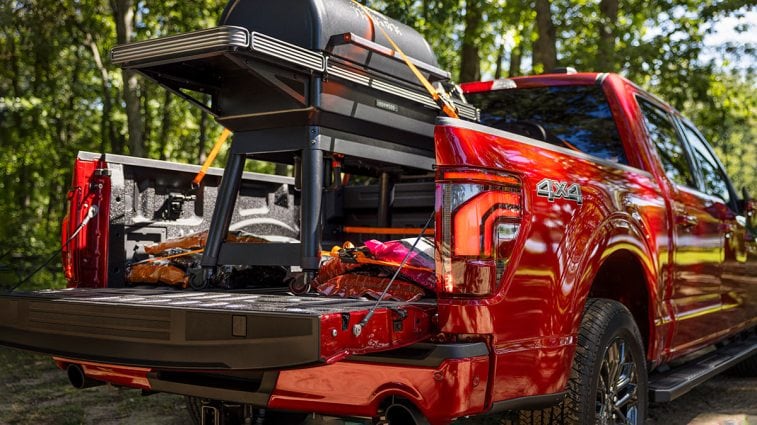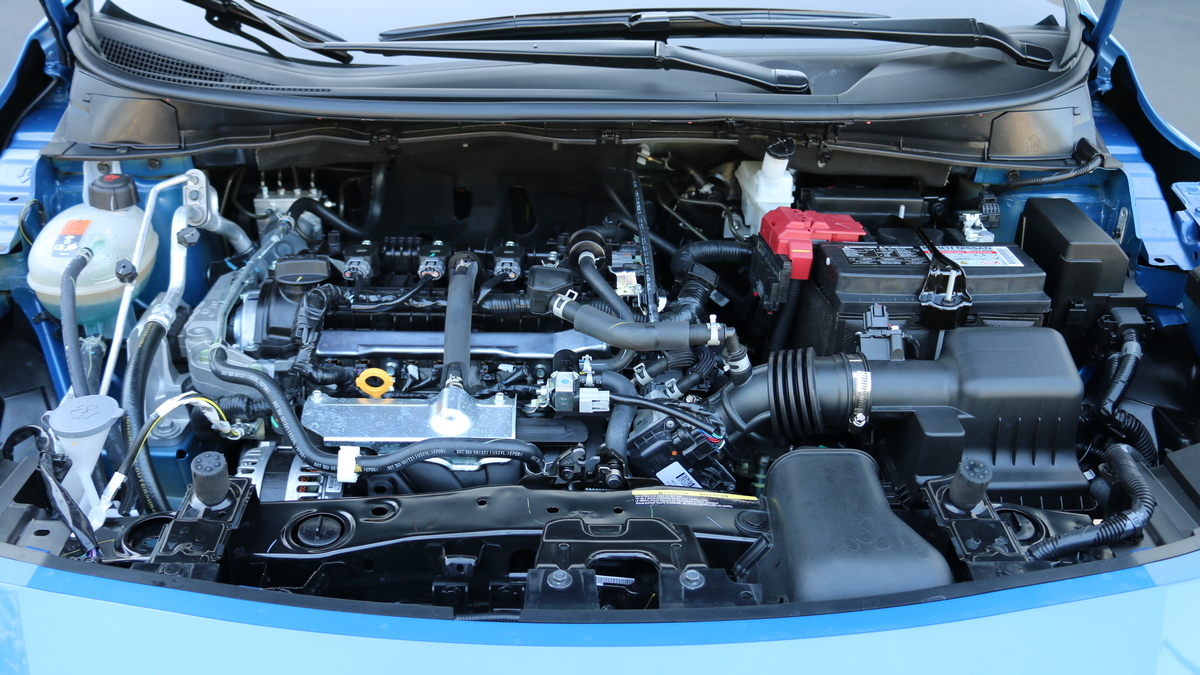
Quick Facts About Payload
- Payload is the combined weight of everything in the vehicle, including passengers.
- Towing capacity is different than payload capacity. It’s typically a higher number.
- Be aware that new tires can change a truck’s payload capacity.
If you’re shopping for a pickup truck or certain kinds of SUVs (more on that in a moment), you’ve likely heard some impressive claims about payload capacity. If you’ve been paying attention, you may have noticed that the payload capacities manufacturers claim have roughly doubled in the past decade.
So, what exactly is payload? Is payload capacity something different? What do you need to know to buy a vehicle capable of safely carrying everything you require? We’ll break it down so you can choose what works best for your situation.
- What Is Payload?
- What Is Payload Capacity?
- Payload Capacity vs. Towing Capacity: What’s the Difference?
- All the Terms You Need for Hauling
- How Do You Calculate Payload Capacity?
- Why Does Payload Capacity Matter?
- Is the Advertised Payload Capacity Accurate?
- How to Increase Payload Capacity
- How to Decrease Payload Capacity
- Pro Tips for Payload Distribution
What Is Payload?
Payload is everything your truck or SUV is carrying, including you and your passengers.
A common misconception among truck buyers is that payload is the amount of weight in the bed. It isn’t. It’s the amount of weight that’s in the bed and the cabin combined. You, dear reader, are part of the payload.
Your new 2025 Toyota Tacoma Double Cab TRD Pro may be capable of carrying up to 1,680 pounds, but don’t load 1,680 pounds of powdered concrete mix into the bed. At most, the truck can carry 1,680 pounds minus your weight, the weight of the passenger who helped you load the concrete mix, and the weight of anything and anyone else you put into the cabin with you.
What Is Payload Capacity?
A vehicle’s payload capacity is the maximum amount of weight it can carry safely. In a truck, it consists of all of the weight in the cabin and bed. In an SUV, car, or van, that includes all the weight in the cabin and trunk.
If you’re pulling a trailer, the payload also includes the weight of the trailer pushing down on the trailer hitch — something called tongue weight.
Payload Capacity vs. Towing Capacity: What’s the Difference?
Payload capacity differs from towing capacity (a far more complicated subject tackled in our Towing Capacity Guide).
Roughly speaking, payload capacity is the amount of weight a vehicle can carry, and towing capacity is the amount of weight it can pull. Automakers often refer to carriage in the truck’s bed as hauling to distinguish it from carrying weight in a trailer or towing.
Towing capacity is higher than payload capacity for the same reason you can pull more weight in a kid’s wagon than you can carry on your shoulders. However, payload capacity factors into towing capacity because an SUV full of people towing a boat behind is comparable to you pulling that wagon and carrying some weight on your shoulders.
RELATED: Traction Control System: How It Works and When to Use It
Key Terms You Need for Hauling
Hauling comes with a much simpler lingo, and easier math, than towing. But there are a few terms that may come up.
| GVWR | Gross Vehicle Weight Rating is the maximum amount of weight a vehicle can hold safely, including itself. GVWR takes into account the strength of the frame, suspension, axles, and wheels. |
| Curb Weight | Curb Weight is the total weight of a vehicle and all the fluids it requires to function (including a filled gas tank), but with no people or cargo inside. |
| Payload | Whatever your vehicle is carrying, including cargo, people, junk in the glove box, flotsam in the center console, and other odds and ends, is payload. That half-eaten pizza shoved under the front passenger seat? Yep, that counts. |
| Tongue Weight | When towing, tongue weight is a measure of the downward force a trailer’s tongue applies to the vehicle’s tow hitch. It’s estimated to be about 10% of the combined weight of the trailer and its load. |
How Do You Calculate Payload Capacity?
Good news — you probably don’t need to calculate your vehicle’s payload capacity. Your owner’s manual will list it. It’s also usually posted on a placard on the driver’s side doorjamb.
This placard may list the weight as “payload capacity,” or under a phrase like “the combined weight of passengers and cargo should never exceed” a certain weight.
If you need to calculate it yourself, subtract the curb weight from GVWR to get the approximate payload capacity.
For example, a 2025 Chevy Silverado 1500 Crew Cab has a GVWR of 6,800 pounds and a curb weight of 4,740 pounds. That’s a difference of 2,060. Chevy claims Its payload capacity is actually 2,030 pounds.
Payload Capacity Ranges for Some Popular Trucks and SUVs
Payload capability is influenced by the engine, transmission, cab configuration, the number of drive wheels (2 or 4), and the size of the cargo bed (box). For example, the 4-wheel-drive 2025 Chevy Silverado 1500 Crew Cab Short Bed ZR2 with the 6.2-liter V8 tops out at a maximum payload of 1,520 pounds. The rear-wheel-drive Silverado 1500 Regular Cab Long Bed with the 5.3-liter V8 can shoulder 2,530 pounds.
Here are payload ranges for some popular 2025 pickup trucks and SUVs.
| Make and Model | Typical Payload Weight Limits in Pounds |
| Chevrolet Colorado | 1,151-1,684 |
| Chevrolet Silverado 1500 | 1,520-2,530 |
| Chevrolet Suburban | 1,539-1,750 |
| Chevrolet Tahoe | 1,616-1,834 |
| Dodge Durango | 1,350-1,590 |
| Ford F-150 | 1,405-2,440 |
| Ford Expedition | 1,400-1,758 |
| Ford Explorer | Up to 1,700 |
| GMC Canyon | 1,250-1,640 |
| GMC Sierra 1500 | Up to 2,250 |
| Jeep Gladiator | Up to 1,725 |
| Ram 1500 Crew Cab | 1,170-1,770 |
| Toyota Tacoma | 1,230-1,680 |
| Toyota Tundra | Up to 1,940 |
Why Does Payload Capacity Matter?
Loading your vehicle with more weight than it is designed to carry is unsafe. Moreover, it’s also probably against the law where you’re driving.
You might be able to get your vehicle to move with a weight greater than the door sticker says it can carry. If so, you’ll find that it doesn’t accelerate fast enough to keep up with traffic, can slide in turns, and most importantly, takes a much longer distance to brake to a complete stop.
Driving that way causes accidents. It also voids your vehicle’s warranty. And that isn’t good because serial overloading means you will eventually need that warranty.
Overloading your vehicle puts more stress on the frame, suspension, and tires than they can handle. It makes the engine and transmission work harder than designed to work. In a best-case scenario, that’s a lot of wear on parts, causing them to fail early. In a worst-case scenario, it will cause them to fail immediately.
Oh, and it voids your auto insurance contract. So, the cost of those repairs will be entirely on you.
Lastly, in many states, it’s illegal. So, when your transmission fails under the strain of a load that the manufacturer said the vehicle can’t carry, and it leaves you blocking traffic, you’ll get a costly ticket on top of the towing bill and everything else.
In short, don’t exceed your vehicle’s payload capacity. Ever. Should you absolutely need to haul more than your vehicle can safely carry, rental trucks are your friend.
Your family or friends may own trucks you can borrow, too. If all else fails, make two trips.
Is the Advertised Payload Capacity Accurate?
If you’re truck shopping, you could hear some very impressive payload capacities advertised. It’s important to note that they are strictly true. But they generally don’t refer to the truck you will buy.
For example, the manufacturer builds and advertises a 2025 Ford F-150 configuration with a payload capacity of up to 2,440 pounds. The bad news is that unless your local Ford dealership serves a heavy commercial clientele, that’s likely a special-order model they don’t keep in stock.
It’s also possible to buy a 2025 F-150 with a payload capacity as low as 1,410 pounds, and your local dealership is far more likely to have that one on the lot to sell you.
Why Do Some SUVs Have Radically Different Payload Capacities Than Others?
Roughly similar vehicles tend to have roughly similar payload capacities. Trucks that compete with one another for sales tend to offer roughly similar payload capacities. The same can’t always be said of SUVs.
Some manufacturers build SUVs on truck frames designed to carry heavier loads and flex a bit to keep all wheels in contact with the ground in off-road situations. Those tend to have higher payload capacities.
Others get built on car frames designed for a smoother on-road ride and crisper handling. Those are great daily drivers but tend to have lower payload capacities. Automakers and the press often, but not always, call those vehicles “crossovers.”
So, you’ll sometimes see two vehicles with radically different payload capacities marketed as being in the same class.
How to Increase Payload Capacity
It’s possible to increase the payload capacity of your existing vehicle. Be careful. There is easily available more bad information than good about how to do so.
After all, payload capacity is affected by the capabilities of many different parts of your vehicle. Upgrading any single one doesn’t enable the others to take more strain.
If you could strengthen your hamstrings but no other body part, trying to squat a heavier weight than ever before would succeed in hurting your back. Likewise, upgrading your truck’s shocks might enable you to damage the frame with a heavy load more successfully.
The safest way to increase payload capacity is to reduce weight. Removing the rear seats will buy you a few extra pounds of carrying capacity. Beyond that, if you must move a heavier load than your vehicle is rated to carry, rent something that can safely do it.
How to Decrease Payload Capacity
On the other hand, it’s pretty easy to lower your vehicle’s payload capacity unintentionally. Anything that adds weight to your truck that it didn’t have when it left the factory cuts into the amount of weight it can carry.
Aftermarket bed liners, truck caps, tonneau covers, and toolboxes are great, functional additions that make a truck a more practical everyday tool. But they all reduce payload capacity. If you add one or more to your vehicle, know the weight, and factor it in every time you haul.
Likewise, new tires can change a truck’s payload capacity. You’re almost certainly going to replace the tires at least once in the lifetime of your vehicle. Consult the manufacturer’s recommendations and the new tires’ weight ratings to ensure you’re not lowering the amount your truck can carry.
Pro Tips for Payload Distribution
It’s essential to ensure you don’t overload your vehicle than with more weight than it can safely carry. It’s also important to ensure you distribute weight as safely as possible. Just as you’d struggle to carry a heavy weight on one shoulder and a light one on the other, your vehicle can quickly get unbalanced with an uneven load.
7 Pro Safety Guidelines for Hauling
- Restrict your estimated payload weight to 90% of the manufacturer’s stated payload capacity to play it safe.
- Place the heaviest items on the bottom. Top-heavy loads are more likely to shift.
- Spread cargo as evenly as possible in the truck’s bed or the SUV’s cargo area.
- Strap heavy items in place so they can’t slide. All trucks for sale in the United States currently have tie-down points for ropes and ratchet straps. A ratchet strap set is much less expensive than damaging your cargo and truck.
- State regulations generally require any object sticking out the back of your vehicle to have a red or orange visibility flag on it. This is so that other drivers can easily see it.
- Remember, when hauling liquids, they slosh and shift their weight around. Store them in small containers to allow as little space as possible for movement, and strap those containers down tight.
- Accelerate and brake gently, leaving extra room between you and any other vehicle so you can do so safely.
RELATED: Maximum Towing Capacity for Every Truck







